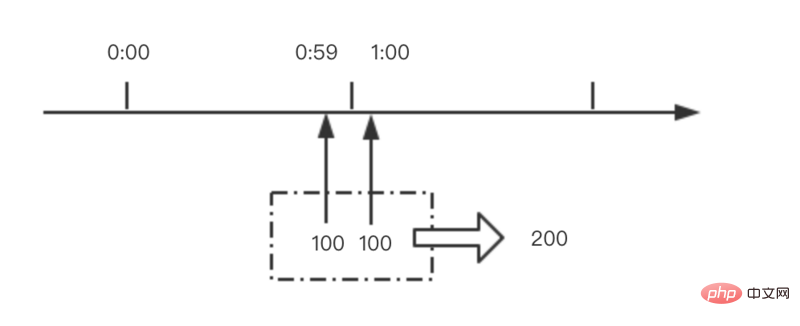When marketing e-commerce platforms, we often encounter large traffic problems. In addition to traffic diversion processing, we may also need to perform user black and white lists and reputation analysis, and then perform corresponding traffic interception and traffic restriction based on the user's IP reputation weight.

Nginx's own request limiting module ngx_http_limit_req_module and traffic limiting module ngx_stream_limit_conn_module are based on the token bucket algorithm, which can easily control the token rate and customize the current limit. , to achieve basic current limiting control.

The algorithm idea is:
Tokens are generated at a fixed rate and cached in the token bucket;
When the token bucket is full, the excess tokens are discarded;
The request must consume an equal proportion of tokens to be processed;
When there are not enough tokens, the request is processed cache.
Leaky Bucket Algorithm:

The algorithm idea is:
Water (Request ) is poured into the bucket from above and flows out from the bottom of the bucket (processed);
The water that is too late to flow out is stored in the bucket (buffer) and flows out at a fixed rate; when the bucket is full, the water overflows (discarded).
The core of this algorithm is: caching requests, processing them at a uniform speed, and discarding redundant requests directly.
Compared with the leaky bucket algorithm, the difference between the token bucket algorithm is that it not only has a "bucket", but also a queue. This bucket is used to store tokens, and the queue is used to store requests.
In terms of function, the most obvious difference between the leaky bucket and token bucket algorithms is whether to allow burst traffic (burst) processing. The leaky bucket algorithm can forcibly limit the real-time transmission (processing) rate of data. Burst traffic does not undergo additional processing; the token bucket algorithm can limit the average transmission rate of data while allowing a certain degree of burst transmission.
The Nginx speed limit module based on the request rate uses a leaky bucket algorithm, which can forcibly guarantee that the real-time processing speed of requests will not exceed the set threshold.
The official version of Nginx has two modules for limiting IP connections and concurrency:
limit_req_zone is used to limit the number of requests per unit time, that is, rate limit, adopted Leaky bucket algorithm "leaky bucket".
limit_req_conn is used to limit the number of connections at the same time, that is, concurrency limit.
For more Nginx related technical articles, please visit the Nginx usage tutorial column to learn!
The above is the detailed content of How to limit nginx flow. For more information, please follow other related articles on the PHP Chinese website!
 内存飙升!记一次nginx拦截爬虫Mar 30, 2023 pm 04:35 PM
内存飙升!记一次nginx拦截爬虫Mar 30, 2023 pm 04:35 PM本篇文章给大家带来了关于nginx的相关知识,其中主要介绍了nginx拦截爬虫相关的,感兴趣的朋友下面一起来看一下吧,希望对大家有帮助。
 nginx限流模块源码分析May 11, 2023 pm 06:16 PM
nginx限流模块源码分析May 11, 2023 pm 06:16 PM高并发系统有三把利器:缓存、降级和限流;限流的目的是通过对并发访问/请求进行限速来保护系统,一旦达到限制速率则可以拒绝服务(定向到错误页)、排队等待(秒杀)、降级(返回兜底数据或默认数据);高并发系统常见的限流有:限制总并发数(数据库连接池)、限制瞬时并发数(如nginx的limit_conn模块,用来限制瞬时并发连接数)、限制时间窗口内的平均速率(nginx的limit_req模块,用来限制每秒的平均速率);另外还可以根据网络连接数、网络流量、cpu或内存负载等来限流。1.限流算法最简单粗暴的
 nginx+rsync+inotify怎么配置实现负载均衡May 11, 2023 pm 03:37 PM
nginx+rsync+inotify怎么配置实现负载均衡May 11, 2023 pm 03:37 PM实验环境前端nginx:ip192.168.6.242,对后端的wordpress网站做反向代理实现复杂均衡后端nginx:ip192.168.6.36,192.168.6.205都部署wordpress,并使用相同的数据库1、在后端的两个wordpress上配置rsync+inotify,两服务器都开启rsync服务,并且通过inotify分别向对方同步数据下面配置192.168.6.205这台服务器vim/etc/rsyncd.confuid=nginxgid=nginxport=873ho
 nginx php403错误怎么解决Nov 23, 2022 am 09:59 AM
nginx php403错误怎么解决Nov 23, 2022 am 09:59 AMnginx php403错误的解决办法:1、修改文件权限或开启selinux;2、修改php-fpm.conf,加入需要的文件扩展名;3、修改php.ini内容为“cgi.fix_pathinfo = 0”;4、重启php-fpm即可。
 如何解决跨域?常见解决方案浅析Apr 25, 2023 pm 07:57 PM
如何解决跨域?常见解决方案浅析Apr 25, 2023 pm 07:57 PM跨域是开发中经常会遇到的一个场景,也是面试中经常会讨论的一个问题。掌握常见的跨域解决方案及其背后的原理,不仅可以提高我们的开发效率,还能在面试中表现的更加
 nginx部署react刷新404怎么办Jan 03, 2023 pm 01:41 PM
nginx部署react刷新404怎么办Jan 03, 2023 pm 01:41 PMnginx部署react刷新404的解决办法:1、修改Nginx配置为“server {listen 80;server_name https://www.xxx.com;location / {root xxx;index index.html index.htm;...}”;2、刷新路由,按当前路径去nginx加载页面即可。
 Linux系统下如何为Nginx安装多版本PHPMay 11, 2023 pm 07:34 PM
Linux系统下如何为Nginx安装多版本PHPMay 11, 2023 pm 07:34 PMlinux版本:64位centos6.4nginx版本:nginx1.8.0php版本:php5.5.28&php5.4.44注意假如php5.5是主版本已经安装在/usr/local/php目录下,那么再安装其他版本的php再指定不同安装目录即可。安装php#wgethttp://cn2.php.net/get/php-5.4.44.tar.gz/from/this/mirror#tarzxvfphp-5.4.44.tar.gz#cdphp-5.4.44#./configure--pr
 nginx怎么禁止访问phpNov 22, 2022 am 09:52 AM
nginx怎么禁止访问phpNov 22, 2022 am 09:52 AMnginx禁止访问php的方法:1、配置nginx,禁止解析指定目录下的指定程序;2、将“location ~^/images/.*\.(php|php5|sh|pl|py)${deny all...}”语句放置在server标签内即可。


Hot AI Tools

Undresser.AI Undress
AI-powered app for creating realistic nude photos

AI Clothes Remover
Online AI tool for removing clothes from photos.

Undress AI Tool
Undress images for free

Clothoff.io
AI clothes remover

AI Hentai Generator
Generate AI Hentai for free.

Hot Article

Hot Tools

Dreamweaver CS6
Visual web development tools

Zend Studio 13.0.1
Powerful PHP integrated development environment

Safe Exam Browser
Safe Exam Browser is a secure browser environment for taking online exams securely. This software turns any computer into a secure workstation. It controls access to any utility and prevents students from using unauthorized resources.

SublimeText3 Mac version
God-level code editing software (SublimeText3)

Atom editor mac version download
The most popular open source editor






